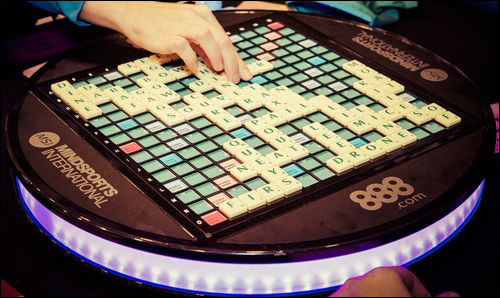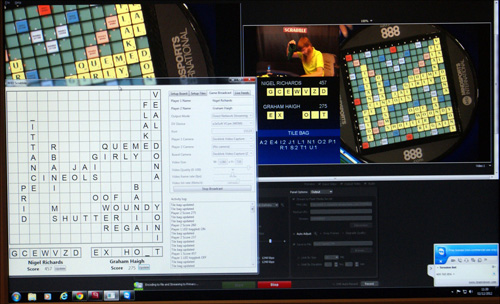Mind Sports International‘s mission is to provide events that bring together the players of “the world’s most popular mind sports.” Last weekend, the company held its inaugural event, Prague Mind Sports Festival 2012, which included not only tournaments for bridge, backgammon, poker and Risk, but also RFID-powered Scrabble matches.
When people think of spectator sports, Scrabble is not typically the first game to come to mind. So the challenge facing Mind Sports International is how to bring the game’s competition to viewers at home in an engaging way. Enter radio frequency identification, which the firm’s parent company, British sports event-management and gaming consultant Living It Loving It, hopes may help present the game to online viewers. For the Prague Mind Sports Festival, the company incorporated the technology into a version of Scrabble, embedding a passive 13.56 MHz RFID tag in each tile, and installing hundreds of reader antennas in the game board and tile holders. The technology, designed by British RFID company IB Technology (IBT), and built by IAG Technology, made it possible for online spectators to see which words were on the board, which letters each player had in his or her possession and the word options being considered by the players, based on how they arranged the tiles on their holders.

IBT developed RFID readers and antenna arrays installed by IAG beneath the game board, in order to capture location data interpreted by Living It Loving It’s software on a Mind Sports server. Using that information, the software indicated each tile’s exact location on the board. During the festival, game enthusiasts were able to sign onto the Mind Sports server and view the matches in real time, says Peter Ramsay, Living It Loving It’s director of marketing.
Mind Sports International plans to organize similar events for competitors worldwide, with the goal of recording and streaming the matches online. Although cameras can capture some of the action, a host of cameras would need to be arranged around a Scrabble table, the company explains, in order to capture a view of the board itself, as well as players’ tiles, and there would be no analytics to help online viewers consider each player’s standing and options.These same types of challenges are addressed via RFID during televised poker games, Ramsay says. RFID tags on cards enable the system to present viewers with details regarding which cards players have in their hands, and the software can then determine the play options and display them before those involved in the match (see RFID Gives Pokertronic Its Strong Suit). Therefore, Living It Loving It’s staff speculated that the technology could provide the same advantages to the game of Scrabble. To that end, the company devised a board that would employ RFID to detect which tile was on each square of the board, thereby allowing software to display that information, along with the letters with which the competitors were working.
To enable the level of location-data granularity necessary to identify a single square on a standard Mattel Scrabble board, IAG installed a total of nine IBT Micro RWD Mifare Icode RFID reader modules, compliant with the ISO 15693 standard, on printed circuit boards installed under the board, and wired to the back-end system running Living It Loving It’s software. Each reader module was wired to 25 antennas.
A Scrabble board has 15 rows of 15 squares on which tiles can be placed, for a total of 225 squares, under each of which IAG attached a single antenna. In addition, says Gary Wade, IAG’s sales director, the company installed a separate reader and antennas for the tile holders that players use to arrange the tiles they have picked, while they consider their next move. Each antenna could read the tag of a tile placed within approximately 4 millimeters (0.2 inch) of that antenna.
Having nine separate readers, arranged in layers beneath the board itself, “removed complications with trying to read from antennas at greater distances away from the reader,” according to Simon Dingley, Living it Loving It’s technical lead. The multiple interrogators, he says, also reduced the cost of damage in the event that one reader was broken on the board, since they can be individually replaced at much less cost than if the system had been designed with a single reader for the entire board, and if that reader had then become broken. “It also offered advantages in terms of read speeds, as the computer can read nine boards in parallel and continue to do so at a far greater speed [than a single reader with that same number of antennas].”
Each square has an antenna coil on the underside of the board, explains IB Technology’s director, Ian Evans, and these are “individually selected—or turned on—briefly as part of the scan process.” The reader software controls the individual selection of the board squares’ antenna, he says and requests the RFID tag ID in the letter tile, by sending commands to the IBT reader. “So you can see that speed is the critical factor here; the host computer has to be able to scan all 225 squares in a reasonably short time—few seconds ideally—to make the game updates responsive and quick.”
The Scrabble board was divided into 5-by-5-inch panels with a single reader and multiple antennas. “The host computer can then effectively scan the nine panels at the same time (or as fast as the host computer can manage), improving the response time considerably.”The passive RFID tags—also supplied by IBT—were adhered to the backs of all 100 Scrabble tiles. Each tile’s unique ID number was then stored in the software, linked to that tile’s letter and the letter’s value. In addition, the software stored a grid indicating which antenna was located at each square. The tournament play software, created by a firm known as The Site Doctor, extracted the information collected via the RFID readers and relayed it to a Web site in an easy-to-follow graphical display, alongside each player’s high-definition (HD) video footage.
The array of antennas wired to the tile holders determined which tiles a player had at any given time, and in what order that individual had placed them on the holder, according to the location of the specific antenna reading the tag. This allowed spectators to view which words a particular player was considering as he or she arranged the tiles on the holder.
The Prague festival, Ramsay explains, acted as a trial run for the technology, which the company says cost in excess of £20,000 ($30,000) to produce. Because the RFID technology appeared to work well in Prague, he adds, Scrabble games will be provided for viewers in the future if they log onto Mind Sports TV, beginning with next year’s Vienna Mind Sports Festival, scheduled for Feb. 12-25.


